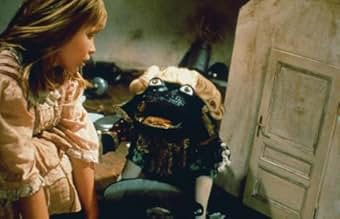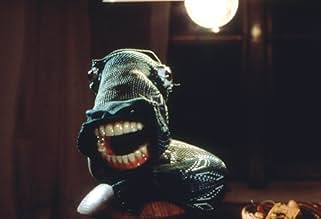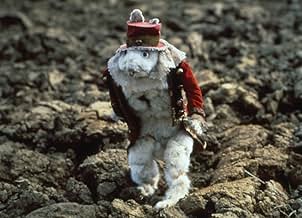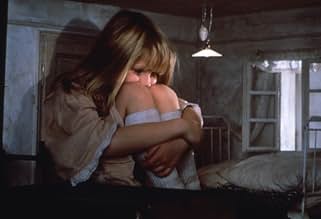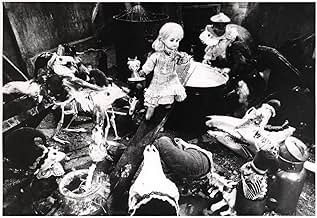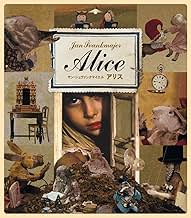Uma revisão surrealista de Alice no País das Maravilhas.Uma revisão surrealista de Alice no País das Maravilhas.Uma revisão surrealista de Alice no País das Maravilhas.
- Direção
- Roteiristas
- Artistas
- Direção
- Roteiristas
- Artistas
- Prêmios
- 1 vitória e 1 indicação no total
Camilla Power
- Alice
- (English version)
- (narração)
- Direção
- Roteiristas
- Elenco e equipe completos
- Produção, bilheteria e muito mais no IMDbPro
Avaliações em destaque
A mix of live action and stop-action, this arthouse flick is intriguing but bizarre. But if I was a little kid I'd be scared out of my wits by The White Rabbit with bulging glass eyeballs & long, hamster-like fangs. Socks become wood-eating worms, Alice starts eating marmalade full of tacks, a tiny mouse lands on her head, punctures it & starts a fire, the rabbit hole she falls down starts as a desk drawer that grabs her & draws her in. The Alice doll she becomes when she's shrunk is sweet but sad. I have to admit it's fascinating and 180 degrees from the saccharine sweetness of the Disney film. See it on video to experience something completely different, and probably more towards the way Lewis Carroll intended the story to be...
Watched this last night - one of my favorites, especially as and ex-art student. He animated everything from socks to lumps of meat. Very dark, and would have been darker yet without the little girls voice over. My favorite scene, I think, is when the water rat sets up camp on her head. There is a lot to watch out for in this film, a hundred little touches, and references. Follows the book to a certain extent, but goes its own lunatic-asylum way. If you have very vivid dreams and wake up in the morning wondering 'what the heck was that all about?', it is a bit like watching this film:)
This movie may be labeled frustratingly plotless by some, and that's fair, but the imagery in this strange combination of stop-motion animation and live footage is so hauntingly rich and evocative that you get the feeling that someone has secretly filmed your own childhood dreams and translated them into Czech - perhaps for the viewing pleasure of the former commissars. The basic idea is that all of ALICE IN WONDERLAND is occurring in Alice's house, and a staggering variety of household items are animated into jerky sort of life, while all the character voices - Mad Hatter, Queen of Hearts, White Rabbit - are spoken by Alice. Alice's house, however, is a Czech house, and the items are old even by Soviet bloc standards. It's as if an antique rummage sale suddenly sprang to life to act out a monstrous little comedy for one girl. And the architecture is simultaneously comforting and frightening. Windows, for example, merely open onto other rooms, all lit by bare light bulbs. What keeps the thing tied to Lewis Carroll is the performance of the little girl playing Alice. She appears to be about six or seven, and despite the disturbing events going on around her, she never appears frightened, and always investigates events as they grow curiouser and curiouser with a determined pluck. This little girl is always in control. What this adaptation lacks in forward momentum or narrative drive it makes up for with a surreal poetry of the domestic space as dreamed by a child.
We have all be introduced by either the written form or the theatrical form of the story of "Alice in Wonderland". Unfortunately, I feel that most of us have been introduced to this story through the film version instead of the written word. Sad as it may seem, we have all been sucked into either the Disney version, the Care Bear's version, or better yet even the recent made-for-TV version that was on ABC. So, with that being said, we all then know the story of Alice's journey through Wonderland. For all of you who have perhaps missed out on this fabled children's tale, let me recap for you quickly:
White Rabbit, Small and Big, Caterpillar, Tweetlede & Tweetledum, the Walrus, the pig baby, the Queen of Hearts, the Mad Hatter, "Off with their heads!!!", the Cheshire cat, and the Alice dream.
Although that may seem like a jumbled line of words and phrases, that actually accurately sums up the entire plot of the children's story. What surprises me is that over time the film versions of this story have not changed. They have continued to show this innocent child being swept up in this imaginary and beautiful "Neverland" where she finds herself being the center of attention. I am not sure if studios are afraid to topple the Disney version, or if there is no creativity running through the minds of writers to make a fresh new story of this old tale, but something needed to be done. It was a tired story, that needed a modern day face-lift. With this said, let me introduce you to the Czech version of this fairy tale. While I applaud it for taking a much darker twist to this story, I do denounce it's use of stop motion animation to create the impossible.
Lewis Carroll, the author of the story, really intended "Alice in Wonderland" to be a very scary and dark story for children, and until Disney put their hands on it...it was. What Czech director Jan Svankmajer has done brought back the darkness to Alice. Almost taken from a page out the directing book by David Lynch, it abruptly begins with Alice announcing that she is going to watch a movie...this movie to be exact. She then proceed to play in her room. The movie does follow the actual story of Alice, but it takes a nightmarish version of the favorite characters. For example, the White Rabbit constantly looses his stuffing, only to pull his watch out of his stomach to proclaim that "He is very late for a date". He refills himself by eating wood chips that immediately fall back out of him. At the Mad Hatter party, a wind-up March Hare sits during the entire scene and butters watches to make sure that the gears get oiled. The lady who was watching the baby who is actually a pig is portrayed in this film as a frog footman who battles flies with a very lifelike tongue. Even the smallest of characters are evil. There is a scene with a door mouse that crawls up Alice's head when she is sitting in a pool of her own tears, and proceeds to set up camp in her hair.
For children...I think not...original...I think YES! While it even ends the same as the other versions of "Alice", the feeling that it leaves in your mind and stomach afterwards will be remembered further more than the cutesy animated version.
I tried hard to like this movie. It was art, it was foreign, it was from my native country...but I just couldn't connect with the stop-motion animation.
I don't want to stray you the wrong way, if you enjoy this style of animation, then I really recommend this film to you. I guarantee that you will never think of "Alice in Wonderland" in the same way. The symbolism was very strong and very poignant. I enjoyed how the feeling of Wonderland actually being a part of the house. I loved how the director used household items to create this normally "pretty or cuddly" characters. I also enjoyed the darkness to this film. When I think about it, I don't think of "Alice in Wonderland" as a children's story. A young girl follows a rabbit through an uncharted area (not worried that she is not home) and creates havoc all throughout this peaceful town. When she is finally caught, her punishment handed down by the elected Queen is not fulfilled...instead she awakens only to discover that it was a nightmare. I was always curious why there were so many cute characters in a nightmare. I think Svankmajer saw the darkness in the story and brought it out in this version.
Overall, I enjoy seeing another side of a story that our society loves so much. I love seeing artists take a vision that we have all seen before and turn it into their own design. I think this was done with this film. I applaud my Czech friend for all of the work on this film, and I suggest tackling yet another children's classic soon!!
Grade: *** out of *****
White Rabbit, Small and Big, Caterpillar, Tweetlede & Tweetledum, the Walrus, the pig baby, the Queen of Hearts, the Mad Hatter, "Off with their heads!!!", the Cheshire cat, and the Alice dream.
Although that may seem like a jumbled line of words and phrases, that actually accurately sums up the entire plot of the children's story. What surprises me is that over time the film versions of this story have not changed. They have continued to show this innocent child being swept up in this imaginary and beautiful "Neverland" where she finds herself being the center of attention. I am not sure if studios are afraid to topple the Disney version, or if there is no creativity running through the minds of writers to make a fresh new story of this old tale, but something needed to be done. It was a tired story, that needed a modern day face-lift. With this said, let me introduce you to the Czech version of this fairy tale. While I applaud it for taking a much darker twist to this story, I do denounce it's use of stop motion animation to create the impossible.
Lewis Carroll, the author of the story, really intended "Alice in Wonderland" to be a very scary and dark story for children, and until Disney put their hands on it...it was. What Czech director Jan Svankmajer has done brought back the darkness to Alice. Almost taken from a page out the directing book by David Lynch, it abruptly begins with Alice announcing that she is going to watch a movie...this movie to be exact. She then proceed to play in her room. The movie does follow the actual story of Alice, but it takes a nightmarish version of the favorite characters. For example, the White Rabbit constantly looses his stuffing, only to pull his watch out of his stomach to proclaim that "He is very late for a date". He refills himself by eating wood chips that immediately fall back out of him. At the Mad Hatter party, a wind-up March Hare sits during the entire scene and butters watches to make sure that the gears get oiled. The lady who was watching the baby who is actually a pig is portrayed in this film as a frog footman who battles flies with a very lifelike tongue. Even the smallest of characters are evil. There is a scene with a door mouse that crawls up Alice's head when she is sitting in a pool of her own tears, and proceeds to set up camp in her hair.
For children...I think not...original...I think YES! While it even ends the same as the other versions of "Alice", the feeling that it leaves in your mind and stomach afterwards will be remembered further more than the cutesy animated version.
I tried hard to like this movie. It was art, it was foreign, it was from my native country...but I just couldn't connect with the stop-motion animation.
I don't want to stray you the wrong way, if you enjoy this style of animation, then I really recommend this film to you. I guarantee that you will never think of "Alice in Wonderland" in the same way. The symbolism was very strong and very poignant. I enjoyed how the feeling of Wonderland actually being a part of the house. I loved how the director used household items to create this normally "pretty or cuddly" characters. I also enjoyed the darkness to this film. When I think about it, I don't think of "Alice in Wonderland" as a children's story. A young girl follows a rabbit through an uncharted area (not worried that she is not home) and creates havoc all throughout this peaceful town. When she is finally caught, her punishment handed down by the elected Queen is not fulfilled...instead she awakens only to discover that it was a nightmare. I was always curious why there were so many cute characters in a nightmare. I think Svankmajer saw the darkness in the story and brought it out in this version.
Overall, I enjoy seeing another side of a story that our society loves so much. I love seeing artists take a vision that we have all seen before and turn it into their own design. I think this was done with this film. I applaud my Czech friend for all of the work on this film, and I suggest tackling yet another children's classic soon!!
Grade: *** out of *****
This film mixes the live action of just one actress - Alice - with a ghoulish array of stop-motion animated characters and objects. Whereas Lewis Carroll's original "Alice in Wonderland" story is a celebration of childhood innocence, fantasy, and magical belief, Svankmajer's "Alice" tells the reverse - the loss of childhood innocence through the pain of coming to terms with a less-than magical world. Inspired by the original tale, Svankmajer uses Carroll's idea of a childishly implausible and wild dream to symbolise an escape from a tormented childhood, rather than a daydreaming fantasy in the sun.
With very little dialogue at all, Alice's job as an actress is restricted entirely to responding appropriately to the puppets - which involves no more than recoiling or widening her eyes. This takes nothing away from the film, however; Alice's muteness is a reflection of the classic "children should be seen and not heard" oppressive school of parenting. Indeed, Alice is seen throughout the film to, despite the hellish surroundings, still wipe her feet on doormats, remove her shoes before entering rooms, and do as she is told. She has been brought up through a harsh discipline that keeps her mute, polite, under control and unquestioning - indeed the very first scene of the film shows her older sister wordlessly slap her for being curious as to the contents of a book. This oppressive discipline is part of what makes up Alice's dismal reality, and hence is part of what she is both trying to escape and rebel from by dreaming.
The sad result is that even Alice's dreams are tormented. Children can only dream about the things presented to them in reality. In the first scenes of the film, the camera pans across Alice's room and displays all the junk carelessly surrounding her - a keen viewer will notice that these are the very same objects that Svankmajer later animates inside Alice's dream. It is precisely because Alice's real world is so abysmal that her dream reflects it. Her house seems devoid of life - we never see any parents, and the sister is still out by the riverside - and the house itself is claustrophobic, dark and utterly unfit for human habitation. The ornaments are stuffed bugs, the only visible food is being pickled in tightly clasped jars, and every single surface is smothered in brown grime. The lack of any other life in the house and the lack of any form of homely care, all depict a tragedy of childhood neglect - Svankmajer blames the nightmare entirely on the parents.
Within her dream, Alice suddenly finds that her room expands outwards into an endless muddy plain. This expanse, a dream of freedom, is tragically desolate and uninviting. Nevertheless, she follows one of her now-animated "toys" (the white rabbit) out into the field. Over the course of the film she will meet with a sailing rat, a truly insane depiction of the Mad Hatter and March Hare, and the murderous Queen of Hearts. But ultimately these are only the dream-animated versions of toys Alice detests. The truly sinister characters in her dream are those that come directly from her house, her life. The pickled jars of food turn out to be mixed with drawing pins, the "Drink Me" and "Eat Me" potions and cakes are bottles of ink and nondescript tarts, a mousetrap spells the demise of the sailing rat; when left on her own in a room, its contents attack her - slabs of meat slither around, bread turns to a porcupine of nails, food cans turn out to contain the stuffed beetles used as ornaments in her house (now living).
It is in this scene that Alice first starts to experience some symbolic victory. Throughout the film we see Alice begin to show more curiosity, begin to learn, begin to rebel against what she is told to do, and begin - most importantly - to come to terms with her surroundings. She is ultimately locked away in a dark room - the culmination of all the negative forces around her - trapped inside a doll of herself. Nothing could be more symbolic of the repressive upbringing that has spawned this twisted dream. She has realised that she's been made into a doll - inhuman. It is with this realisation that Alice achieves her first rebellion, tearing her way out of the doll and - through unhindered curiosity - discovers the key to leave the room by.
We are constantly reminded that the dream is a learning process for Alice. Every single time there is dialogue within the film, we immediately see Alice's lips say the words "...the March Hare said", or "...Alice thought to herself". These metatextual scenes suggest Alice is fully aware that this is all a story of her own imaginings. At bare minimum, it suggests that Alice has a level of awareness that oversees the story as a whole - she is looking upon these events with some purpose.
Alice wakes from her dream a changed person. She has grown up the hard way - her last vain attempt at a childish fantasy built from her sordid life has led her to come to terms with how reality really is. She has learnt that we cannot be mute and polite little girls - the world will attack us, and we must defend ourselves. It's a sorry world-view she ends up with, but one necessary for her to be able to live in the neglected environment she's been brought up in. Thus the film ends with her own decision and dialogue - "the rabbit is late again" - she snaps a pair of scissors - "perhaps I'll cut his head off".
Svankmajer's "Alice" is a masterpiece of stop-motion animation. Puppets come terrifyingly to life, and the surreal dream Alice undergoes is an intensely striking barrage of disturbing images. It is no film for children.
With very little dialogue at all, Alice's job as an actress is restricted entirely to responding appropriately to the puppets - which involves no more than recoiling or widening her eyes. This takes nothing away from the film, however; Alice's muteness is a reflection of the classic "children should be seen and not heard" oppressive school of parenting. Indeed, Alice is seen throughout the film to, despite the hellish surroundings, still wipe her feet on doormats, remove her shoes before entering rooms, and do as she is told. She has been brought up through a harsh discipline that keeps her mute, polite, under control and unquestioning - indeed the very first scene of the film shows her older sister wordlessly slap her for being curious as to the contents of a book. This oppressive discipline is part of what makes up Alice's dismal reality, and hence is part of what she is both trying to escape and rebel from by dreaming.
The sad result is that even Alice's dreams are tormented. Children can only dream about the things presented to them in reality. In the first scenes of the film, the camera pans across Alice's room and displays all the junk carelessly surrounding her - a keen viewer will notice that these are the very same objects that Svankmajer later animates inside Alice's dream. It is precisely because Alice's real world is so abysmal that her dream reflects it. Her house seems devoid of life - we never see any parents, and the sister is still out by the riverside - and the house itself is claustrophobic, dark and utterly unfit for human habitation. The ornaments are stuffed bugs, the only visible food is being pickled in tightly clasped jars, and every single surface is smothered in brown grime. The lack of any other life in the house and the lack of any form of homely care, all depict a tragedy of childhood neglect - Svankmajer blames the nightmare entirely on the parents.
Within her dream, Alice suddenly finds that her room expands outwards into an endless muddy plain. This expanse, a dream of freedom, is tragically desolate and uninviting. Nevertheless, she follows one of her now-animated "toys" (the white rabbit) out into the field. Over the course of the film she will meet with a sailing rat, a truly insane depiction of the Mad Hatter and March Hare, and the murderous Queen of Hearts. But ultimately these are only the dream-animated versions of toys Alice detests. The truly sinister characters in her dream are those that come directly from her house, her life. The pickled jars of food turn out to be mixed with drawing pins, the "Drink Me" and "Eat Me" potions and cakes are bottles of ink and nondescript tarts, a mousetrap spells the demise of the sailing rat; when left on her own in a room, its contents attack her - slabs of meat slither around, bread turns to a porcupine of nails, food cans turn out to contain the stuffed beetles used as ornaments in her house (now living).
It is in this scene that Alice first starts to experience some symbolic victory. Throughout the film we see Alice begin to show more curiosity, begin to learn, begin to rebel against what she is told to do, and begin - most importantly - to come to terms with her surroundings. She is ultimately locked away in a dark room - the culmination of all the negative forces around her - trapped inside a doll of herself. Nothing could be more symbolic of the repressive upbringing that has spawned this twisted dream. She has realised that she's been made into a doll - inhuman. It is with this realisation that Alice achieves her first rebellion, tearing her way out of the doll and - through unhindered curiosity - discovers the key to leave the room by.
We are constantly reminded that the dream is a learning process for Alice. Every single time there is dialogue within the film, we immediately see Alice's lips say the words "...the March Hare said", or "...Alice thought to herself". These metatextual scenes suggest Alice is fully aware that this is all a story of her own imaginings. At bare minimum, it suggests that Alice has a level of awareness that oversees the story as a whole - she is looking upon these events with some purpose.
Alice wakes from her dream a changed person. She has grown up the hard way - her last vain attempt at a childish fantasy built from her sordid life has led her to come to terms with how reality really is. She has learnt that we cannot be mute and polite little girls - the world will attack us, and we must defend ourselves. It's a sorry world-view she ends up with, but one necessary for her to be able to live in the neglected environment she's been brought up in. Thus the film ends with her own decision and dialogue - "the rabbit is late again" - she snaps a pair of scissors - "perhaps I'll cut his head off".
Svankmajer's "Alice" is a masterpiece of stop-motion animation. Puppets come terrifyingly to life, and the surreal dream Alice undergoes is an intensely striking barrage of disturbing images. It is no film for children.
Você sabia?
- CuriosidadesDirector Jan Svankmajer had been disappointed by other adaptations of Carroll's book, which interpret it as a fairy tale. His aim was instead to make the story play out like an amoral dream.
- Erros de gravaçãoAfter testing the wooden mushroom fragments, Alice puts the piece that shrinks things in her right pocket and the other that enlarges things in the left one. In the next scene she encounters a tiny house and takes out the right hand fragment to enlarge it.
- ConexõesFeatured in Brows Held High: Alice (2011)
Principais escolhas
Faça login para avaliar e ver a lista de recomendações personalizadas
- How long is Alice?Fornecido pela Alexa
Detalhes
- Tempo de duração
- 1 h 26 min(86 min)
- Mixagem de som
- Proporção
- 1.37 : 1
Contribua para esta página
Sugerir uma alteração ou adicionar conteúdo ausente

